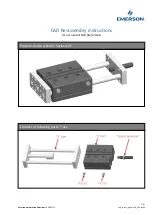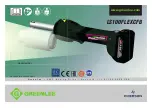
OPERATION AND MAINTENANCE MANUAL
Semi-automatic BOV Crimping Machine Z-2312
A0310.01.2312.905.1.EN
Page 20/33
Tab. 4. Crimping Module Defects, causes and elimination
DEFECTS
CAUSES
ELIMINATION
Crimping diameter changes.
Control measurements show a
constant increase
Actuator is incorrectly locked on
the crimping unit piston
1.
Open the compressed air
supply
2.
Unscrew the crimping head
3.
Apply the wrench on the
actuator and tighten it
Control measurements of the
crimping diameter show
measurement differences outside
the acceptable tolerances
Erosion on the friction surface
between the clamps and the
actuator pin
Replace the actuator clamps and
pin
No lubrication
Lubricate the friction surface of
the crimping clamp and actuator
pin once or twice per day with
Molykote lubricant
Too low crimping height increases
the edge resistance and thus the
erosion of an opening clamp and
actuator pin is increased
Check the crimping height
Control measurements of the
clamp height show size differences
exceeding the acceptable
tolerances
Erosion of the groove in the
opening clamps socket. Clamp
parts are not located at the same
height.
Replace the opening clamps
socket.
One of the clamp parts is not from
the same batch (set).
Check the number of each clamp
segment – these must be the
same. Never replace single
segments but the whole set
Can is jammed in the crimping
head
Elastic ring is damaged, the clamp
does not close completely
Replace the elastic ring
Crimping height is too low
Adjust the crimping height
The crimper descends but does
not return to its initial position.
Arm lever on the return valve does
not move.
Supply pressure is too low.
Adjust the reducing valve in the air
preparation unit: minimum
pressure 6 MPa. Nominal working
pressure 8 MPa
Weak lubrication of the crimping
head.
Lubricate the crimping head
Unscrewed adjustment bolt in the
lever switch
Adjust the bolt ad lock with a
counter nut.
Summary of Contents for Z-2312
Page 36: ...PNEUMATIC DIAGRAMS...
Page 38: ...SPARE PARTS LIST WITH TECHNICAL DRAWINGS...
Page 44: ...ELECTRIC DIAGRAMS...
















































